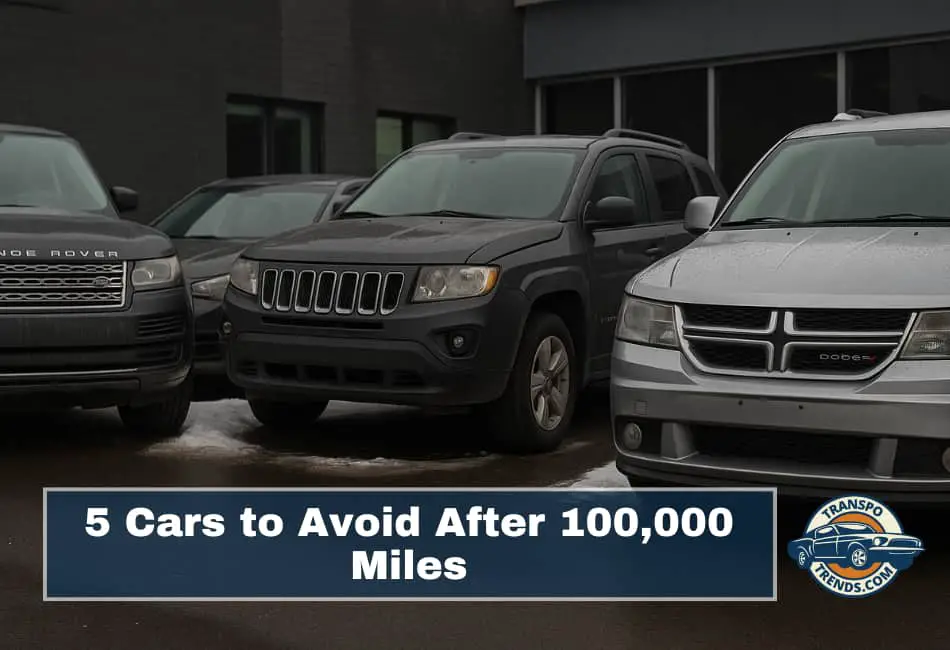Buying a used car is always a bit of a gamble, but when you’re shopping for a car that has already crossed the 100,000-mile mark, the stakes get even higher.
Some vehicles are known for their impressive longevity, continuing to provide reliable service well past the 200,000-mile mark with minimal issues.
Unfortunately, some cars, no matter how good they seem initially, can turn into money pits once they cross that 100,000-mile threshold.
In this listicle, we’re diving into five cars that are best avoided once they’ve surpassed that magical 100,000-mile marker: the Range Rover, Kia Optima, Jeep Compass, Maserati Ghibli, and Dodge Journey.
These vehicles may look good on paper, but their reputations for reliability issues will likely leave you stranded on the side of the road—emotionally and financially. Let’s explore why these cars are best left in the past for any serious car buyer.
1. Range Rover: The Luxury Money Pit
Why It’s Untrustworthy
When you think of luxury SUVs, the Range Rover is undoubtedly one of the first names that comes to mind. It’s a symbol of elegance, off-road capability, and top-tier comfort.
However, once this high-end SUV hits the 100,000-mile mark, it’s no longer just about luxury—it’s about dealing with expensive repairs and constant breakdowns.
According to RepairPal, the Range Rover’s reliability drops significantly after 100,000 miles. Owners commonly report engine issues, oil and coolant leaks, and electrical failures, all of which can result in hefty repair bills.
In fact, many owners of older Range Rovers report issues with low engine compression, which leads to a loss of power and the potential for engine failure.
As a result, owners are often forced to pay thousands for repairs that could rival the cost of purchasing a new car.
Emotional Toll
While the Range Rover is a dream car when it’s running smoothly, it becomes a nightmare as soon as something goes wrong.
The cost of repairs coupled with the constant worry of breakdowns will strip the joy from owning this luxury vehicle.
Why It’s a Money Pit
If you’re unlucky enough to deal with the engine issues, coolant leaks, and electrical faults, you’ll be facing expensive repairs every few months. This kind of maintenance can drain your wallet faster than you can fill up the tank.
Tips for Buyers
- Avoid purchasing a Range Rover that has not been well maintained. Look for a full service history from a Land Rover dealer.
- If you insist on buying one, get a pre-purchase inspection from a mechanic specializing in Land Rovers to check the engine, suspension, and electrical system.
2. Kia Optima: The Affordable Trap
Why It’s Untrustworthy
The Kia Optima may be attractive due to its affordable price tag, sleek design, and decent fuel economy, but its reliability after 100,000 miles leaves much to be desired.
Models from 2011-2017 are particularly prone to engine failures and transmission issues, with many owners reporting problems with the 2.4L and 2.0L engines. These engines suffer from bearing wear, which can lead to engine seizures and costly repairs.
CarParts.com highlights that transmission problems in the Optima, such as jerking or slipping, are common, and many of these issues arise once the car hits 100,000 miles.
This doesn’t even account for the electrical faults that plague certain models, often leaving drivers with a non-starting vehicle or complete system failure.
Emotional Toll
The Optima is the kind of car that feels like a reliable commuter vehicle until the engine fails, the transmission starts slipping, or the electrical system completely dies. The frustration of owning a car that you thought would be reliable but instead ends up being a constant source of repair bills can feel like a betrayal.
Why It’s a Money Pit
After surpassing 100,000 miles, the Optima’s engines and transmissions become ticking time bombs. Repairing or replacing these parts can be incredibly expensive—often costing over $4,500.
While it may seem like an affordable car at first, the cost of maintenance quickly makes it a poor investment.
Tips for Buyers
- Stick to 2018 models and beyond, as they have fewer reported issues.
- Prior to purchasing any used Optima, have the engine and transmission inspected thoroughly, and check for recall history related to engine replacements.
3. Jeep Compass: The Rugged Disappointment
Why It’s Untrustworthy
The Jeep Compass is marketed as a rugged, off-road-capable SUV, but its reliability after hitting 100,000 miles is questionable at best.
Early models (2007-2008) suffer from TIPM (Totally Integrated Power Module) failures, which can cause the fuel pump, headlights, and other essential systems to malfunction.
Newer models (2017-2018) are plagued with issues like engine shut-offs and CVT transmission overheating, often occurring before 100,000 miles, according to autopom!.
While it may look tough on the outside, the Compass struggles to maintain its reliability as the miles pile on. The CVT transmission issues alone can be a deal-breaker, leading to loss of acceleration or complete transmission failure.
Emotional Toll
The Jeep Compass looks the part of a dependable off-roader, but when it leaves you stranded on the side of the road with sudden engine shut-offs or transmission problems, that rugged reputation feels more like a joke.
Why It’s a Money Pit
When your car can’t even keep the engine running, or your transmission starts acting up, the cost of repairs quickly adds up.
As Jeep Compass owners know, these issues often occur sooner than expected, forcing you to constantly visit the mechanic.
Tips for Buyers
- Choose 2019 or newer models, which have had fewer reported issues.
- Check for recalls and maintenance history prior to purchasing.
- Have the transmission and electrical system thoroughly checked by a mechanic.
4. Maserati Ghibli: The Exotic Letdown
Why It’s Untrustworthy
The Maserati Ghibli is a beautiful luxury sedan that offers high-end performance, but it comes with a hidden price tagwhen it hits 100,000 miles.
iSeeCars.com notes that the Ghibli has an average lifespan of just 98,264 miles, and once it crosses that threshold, catastrophic issues can arise.
Owners report engine failures caused by metal particles in the oil filter, and problems with electrical systems such as faulty sensors and gauges are common.
The Emotional Toll
While driving a Maserati is undoubtedly thrilling, the cost of repairs when things go wrong can quickly turn your dream car into a nightmare.
A $20,000 engine replacement is not a fun surprise, especially when it happens so soon after reaching the 100,000-mile mark.
Why It’s a Money Pit
The Maserati Ghibli is a classic case of style over substance. While it looks great on paper, its long-term reliability is far from impressive, with repair costs that can exceed the value of the car itself.
Tips for Buyers
- Stick to low-mileage models with a full service history.
- Consider purchasing an extended warranty to help manage potential repair costs.
5. Dodge Journey: The Family Fiasco
Why It’s Untrustworthy
The Dodge Journey is marketed as a family-friendly SUV, but its reliability after 100,000 miles leaves much to be desired.
Water leaks, transmission issues, and premature brake wear are just a few of the problems that owners report. Specifically, the 2014 Dodge Journey suffers from head gasket issues that can lead to severe engine damage.
Despite being marketed as a practical vehicle for families, the Dodge Journey can often turn into a maintenance nightmare as the miles accumulate.
Emotional Toll
The Dodge Journey offers promises of family vacations and hassle-free driving, but water leaks and constant breakdowns can quickly turn those dreams into frustration.
The added cost of frequent repairs, especially on long road trips, can make the Journey feel more like a burden than a convenience.
Why It’s a Money Pit
With frequent repairs for issues like transmission problems and water leaks, the cost of ownership on a high-mileage Dodge Journey can add up quickly. What was supposed to be a family-friendly SUV ends up being a money pit.
Tips for Buyers
- Choose 2019-2020 models, which have fewer reported issues.
- Have the transmission and water systems checked before purchasing.
Summary Table
| Truck/Car Model | Key Issues | Impact | Recommended Tips |
|---|---|---|---|
| Range Rover | Engine compression, electrical faults, leaks | Expensive repairs, poor reliability | Look for full service history, have a pre-purchase inspection |
| Kia Optima | Engine failure, transmission problems | Expensive engine and transmission repairs | Opt for newer models, check engine history |
| Jeep Compass | TIPM failure, engine shut-offs, CVT issues | Engine and transmission failure, costly repairs | Choose newer models, inspect transmission and electrical system |
| Maserati Ghibli | Engine failures, electrical issues | Expensive repairs, engine replacement costs | Look for low-mileage models, consider extended warranty |
| Dodge Journey | Water leaks, transmission issues | High repair costs, engine damage | Choose later models, have transmission and water systems inspected |
Conclusion
When shopping for a used car, especially one that has passed the 100,000-mile mark, reliability should be your number one priority.
While the Range Rover, Kia Optima, Jeep Compass, Maserati Ghibli, and Dodge Journey might look appealing at first, their reliability issues can quickly turn your new purchase into a headache.
Be sure to do your homework: check recalls, inspect maintenance records, and have a trusted mechanic thoroughly evaluate any used vehicle before buying. A little research can save you a lot of money and frustration down the road.

